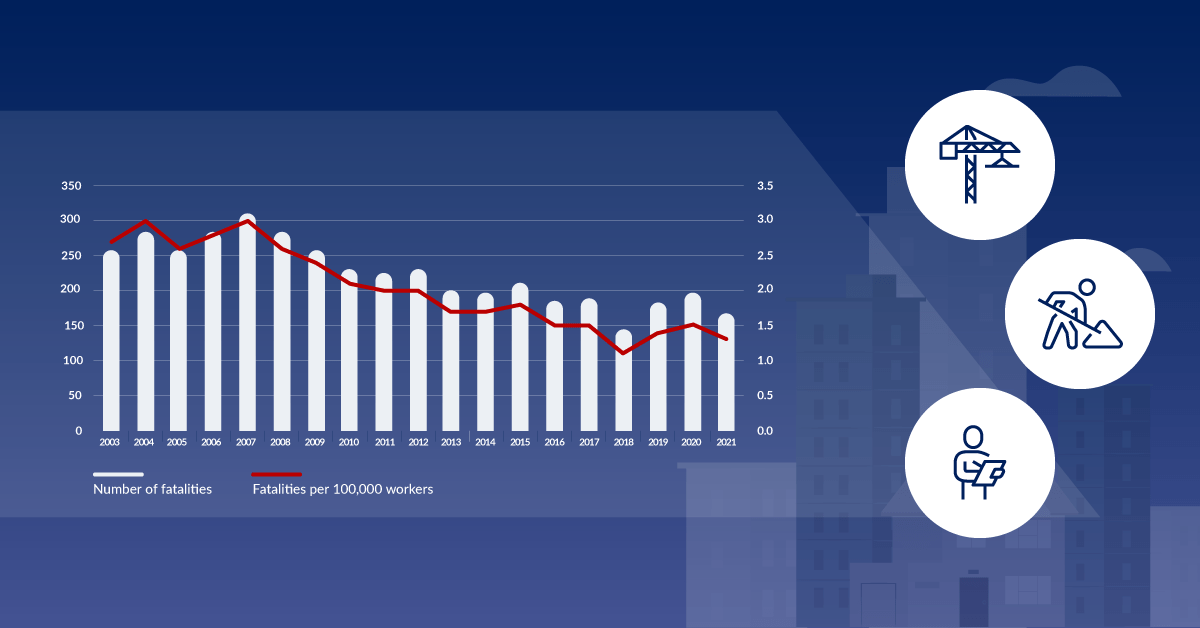Workplace fatalities are the most extreme consequence of unsafe conditions and an unprepared workforce.
Whilst their occurrence in Australia has reduced by over a third in the past decade, Safe Work Australia’s recently published Key Work Health and Safety Statistics, Australia 2022 report reveals that 169 people lost their lives at work in 2021. In addition, there were over 130,000 serious workers’ compensation claims during this reporting period.
The top five nature of injuries or disease for compensation claims were:
- Traumatic joint/ligament and muscle/ tendon injury
- Musculoskeletal and connective tissue diseases
- Wounds, lacerations, amputations and internal organ damage
- Fractures
- Mental health conditions
Whilst mental health conditions represented just 9% of serious claims, the median time lost was 30.7 working weeks per serious claim, with an average compensation payment of $55,270. In comparison, physical injuries and diseases saw a median lost time of 6.2 working weeks and compensation payment of $13,883.
What industries had the highest worker fatality rate?
The nature of the work required in each industry can bring about an inherent level of risk, and Safe Work Australia’s data reflects this relationship between high-risk industries and workplace fatalities. However, even lower risk industries were not untouched. Whilst Agriculture, Forestry & Fishing held the highest fatality rate at 10.4 per 100,000 workers, there were still worker deaths in Administrative Services (5), Arts & Recreation (5), and Retail Trade (1).
| Industry of Employer | Number of Fatalities | Fatalities per 100,000 workers |
| Agriculture, forestry & fishing | 33 | 10.4 |
| Transport, postal & warehousing | 52 | 7.9 |
| Mining | 6 | 2.3 |
| Construction | 24 | 2.1 |
| Arts & recreation services | 5 | 2.1 |
| Electricity, gas, water & waste services | 3 | 2.1 |
| Manufacturing | 16 | 1.8 |
| Administrative & support services | 5 | 1.2 |
| Wholesale trade | 4 | 1.1 |
| Rental, hiring & real estate services | 2 | 0.9 |
| Public administration & safety | 6 | 0.6 |
| Other services | 3 | 0.6 |
| Education & training | 4 | 0.4 |
| Accommodation & food services | 2 | 0.2 |
| Health care & social assistance | 2 | 0.1 |
| Professional, scientific & technical services | 1 | 0.1 |
| Retail trade | 1 | 0.1 |
| Financial & insurance services | 0 | 0.1 |
| Information media & telecommunications | 0 | 0.1 |
What are the leading causes of work-related fatalities?
| Mechanic | Count | Percentage |
| Vehicle collision* | 64 | 38% |
| Being hit by moving objects | 24 | 11% |
| Falls from a height | 19 | 11% |
| Being hit by falling objects | 16 | 9% |
| Being trapped by moving machinery | 11 | 7% |
| Other mechanisms | 35 | 21% |
*Includes fatalities that occurred as a direct result of a vehicle crash, and includes not only road vehicles such as cars and trucks, but also machines such as aircraft, boats, loaders, tractors and quad bikes.
What kinds of workers are most at risk?
Certain occupations were significantly overrepresented in Safe Work Australia’s report. 40% of workplace fatalities in 2021 were Machinery Operators & Drivers (68). Of the remaining 60%, the vast majority were Labourers (34), Managers (24), or Technicians & Trade Workers (22).
Similarly, the top four occupations that saw serious compensation claims were:
- Labourers
- Machinery operated and divers
- Technicians and trades workers
- Community and personal service workers
Read: Managing Risks of Hazardous Manual Tasks
Managing the risks in your workplace
The statistics outlined in Safe Work Australia’s Key Work Health and Safety Statistics, Australia 2022 report are a sombre reminder of the risks faced in workplaces across the country, however should serve to remind Persons Conducting a Business or Undertaking (PCBU), or employers, of important areas to focus on establishing excellence in their safety management systems.
“Work-related fatalities, injuries and illnesses have a devastating impact on workers, their families and the community. Through our analysis of data and research, we are gaining better insights into future work health and safety and workers’ compensation challenges.
The changing nature of work and workplaces, the shift in workforce demographics and the evolution of new technologies present new risks but also provide us with new opportunities to improve WHS in a changing world.”
Michelle Baxter, CEO, Safe Work Australia
Organisations should seek to build an effective culture around safety, both with direct employees and the engagement of contractors. Fundamental elements include:
- Having a comprehensive understanding of the nature of their work
- Conducting thorough risk assessments
- Eliminating risks as far as reasonably practicable
- Implementing appropriate controls
- Setting and communicating policies and procedures
- Delivering tailored training and inductions
- Prequalifying contractors based on their preparedness for the work required of them
A Safety Management System should be continually revisited to adapt, refine, and improve based on changes in their organisation, a project’s life cycle, and the industry as a whole.
Read next: What Does Leadership in Safety Look Like?
